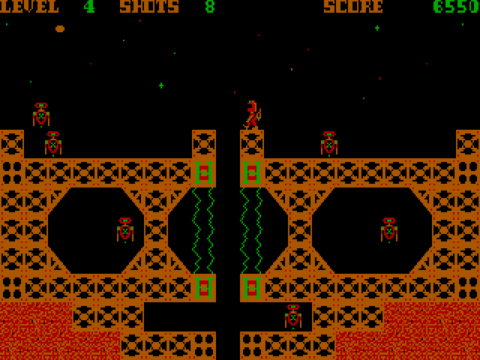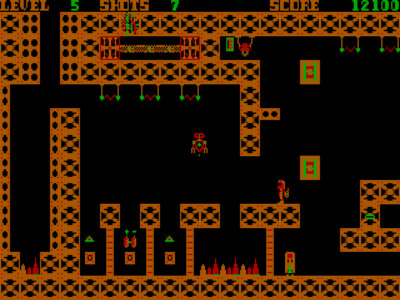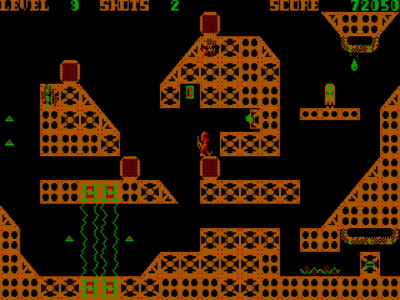
Monuments of Mars
Written by: Stoo
Date posted: December 6, 2018
- Genre: Action
- Developed by: Scenerio software, or more likely Scenario.
- Published by: Apogee Software
- Year released: 1990, or possibly 1991.
- Our score: 5
During the first few years of the 90s, Apogee Software (later 3D Realms) released numerous platform games for PC. Today we’re looking at an early and fairly obscure title from their archives: Monuments of Mars. It was written by Todd Replogle, who’s best known as a co-creator of the Duke Nukem series. For copyright purposes he went under the name “Scenerio Software”, and that second “e” is not my error. To be fair that’s not the worst typo in Apogee’s history; George Broussard got his own name wrong on Pharoah’s Tomb.
I’m guessing the setting for Monuments was based on the supposed face and pyramids on mars, first spotted by the Viking missions in the 70s (hold on, he’s going all NASA nerd on us – ed). It was a rather fanciful idea, even before better quality images proved the features to be natural in origin. Yet it’s also a great inspiration for science fiction, prompting us to imagine ancient and mysterious artificial structures, built by a long lost alien civilization.
In the introductory text we are told that NASA missions to explore the monuments have ended in failure, and all contact has been lost with the astronauts. You have been sent in a final attempt to uncover the secrets of mars. Venturing into the vast structures you must navigate your way past the dangers that they contain, find your fellow explorers, and ultimately try to learn who built the monuments.
That sounds a bit grandiose; ultimately this is just a platform game where you hop over pits, dodge robots and collect things until you’re told well done, you won. Any plot is a few lines of text and I’ll tell you right now, the “secrets of mars” are something hastily thrown in at the end of the last level. We didn’t really export more, back then.
The exact release date is apparently now lost to time. According to the 3D Realms website, their notes say only “unknown 1990”. The title screen however states 1991. So either they didn’t think to load up their own game and check that, or the latter year was some sort of re-release. Anyway according to Wikipedia it’s based on a game engine called FAST (Fluid Animation Software Technology). This was was created by Broussard to power his own Pharoah’s Tomb and Arctic adventure.
The graphics are CGA, which was capable of just four colours on screen at any time from a total palette of sixteen. This meant that Monuments looked rather outdated from the moment it was released (whichever year). By the start of the 1990s EGA, with sixteen onscreen colours, was a common standard. In fact 256-colour VGA was already starting to appear. Many games still supported CGA, for people stuck with outdated PCs (you can play four colour Monkey Island if you really want), but it was becoming rare for it to be the only option.
CGA was a long way behind the capabilities of other formats too. NES fans would have thought that Monuments looked rather spartan. Amiga owners had wonderful graphics that comfortably outmatched EGA, so this game would have them rolling around in derisive laughter (the gits). I probably shouldn’t mention the bleepy PC-speaker sound effects or the lack of music; the adlib sound card had only recently appeared and Apogee wouldn’t support it for another year or two.
Since I like to look for positives, let’s at least note that the right colours were chosen, with most of each level drawn in red and orange. Those rusty tones do help everything feel a bit more Martian, and it’s less garish than the cyan-and-magenta combination that was often used in CGA.

Martian architecture involves a lot of girders.
Moving on from audio-visual stuff, MoM is broken up into four chapters. Following the standard Apogee model of releasing games, the first chapter was given away as shareware. This meant we got a substantial chunk of content for free. Many of us probably never went on to buy the remaining portions of their games, I know I (ahem) didn’t. Yet the model clearly worked given Apogee’s success, and the fact they kept on using it right through to Duke Nukem 3D.
Each chapter comprises 20 levels. Each of these in turn is enclosed within a single screen, as the game doesn’t support any sort of scrolling (Yeah yeah, I know Mario had been doing it since 1986). The levels are filled with various dangers – expect spikes, electric arcs, lasers that shoot whenever you pass horizontally. There are also alien creatures (one of which appears to have come from Commander Keen), and floating robots. Most levels require you to pick up a keycard to open a door blocking the exit. You also have to flip switches to deactivate hazards, or set elevators going.
It’s easy to die, since hitting any enemy or hazard is instantly lethal, forcing caution on your part. In fact on a few levels you have about 3 seconds to take action before you hit something. Robots and aliens can be shot with your blaster, as can control units for some of the lasers. However, it’s often better to just avoid enemies if you can, saving shots for times when they are truly needed. Since enemies move on fixed paths, its usually easy to time your movements and slip past them.
There are a few more features that you will encounter. A certain type of boulder can be pushed and falls under gravity; these can’t kill you but may block your progress. Occasionally platform blocks are triggered to appear by standing in certain locations, something you can only really find out by accident, or by blundering around when stuck.
Apart from avoiding lethal threats, you also have to watch out for putting the current level in an unwinnable state. You might fall somewhere you can’t jump out of, or push a boulder in the wrong direction causing it to block further progress. Or you may just worry that you wasted too much ammo. This adds to the trial-and-error aspect of the game, but fortunately hitting F6 immediately restarts the level so you can try again.
This isn’t a fast, intense sort of game. It’s more one of careful movement and a bit of thinking. Beating each level requires you to figure out the best order in which to hit switches and grab the key, ration your shooting and be careful with boulders. It’s never truly complex, but some levels do take on an element of puzzle solving.
While beating each level carries a certain sense of satisfaction, it can start to feel a bit generic after a while. You walk, jump, zap things a bit, all standard platforming procedure. There’s a lack of any sort of distinctive feature, not much you do here that you didn’t in a bunch of 80s platform games. The maps inevitably become samey, and your hero is an utterly anonymous astronaut.
I was sat here puzzling over what exactly the game could realistically have benefitted from, to give it more of its own identity. The idea occurred to me, give your guy another ability or powerup. Like maybe, a rocket pack! For reaching high areas… Limit the fuel, and you add further depth to this function. Now the player has another resource to conserve, and may have to take risky detours to gain more fuel, for the potential reward of bypassing other hazards.
(I’m sure Mr Replogle will soon be reading this and thinking to himself, why oh why didn’t I have the wisdom of this random blogger with 30 years hindsight and no clue about writing games)

You will need to push some of those boulders, but if they end up in the wrong place they will make the level impassable.
Anyway, though, even if the levels do blur into each other a bit, I didn’t find myself bored or frustrated. It’s actually a fairly short game, because you can rattle though the levels at quite a pace. For a start, you have infinite lives. Also, individual levels are fairly brief. So if you get stuck on something, like a tricky jump onto a small platform with a patrolling monster, you don’t have to replay for long before taking another try at it.
So despite not being the most skilled of gamers (to put it mildly), I ended up finishing the entire thing within a single weekend, and that felt like a suitable duration. Maybe a few trickier puzzles would have been welcome, but I don’t think I would have wanted to spent several weeks working through this.
For a final note before I wrap up, I did encounter a few glitches in the controls, but nothing that I would consider truly detrimental. Sometimes my character would jump or fire their blaster twice for a single keypress (in the worst cases resulting in death or forcing a level restart). Also the collision detection can be a bit dodgy when jumping onto the lower edge of a diagonal ramp.
The early 90s were a time when the PC was still not particularly well regarded for action gaming. It was a dorky beige workstation, maybe something that beardy people played flight sims on, but not the system of choice for platform games or shoot ’em ups. You were much better off with a console or an Amiga. Monuments isn’t really going to challenge that viewpoint; It’s all a bit basic and clunky. It actually makes me think of a cheap game for an 8-bit microcomputer, but those at least had music (and sometimes scrolling).
If you’re just looking for the highlights of Apogee’s platform game selection, I’d point you at some of their more advanced and refined titles like commander Keen 4, Duke Nukem 2 or Cosmo’s cosmic Those ones benefitted from EGA graphics, scrolling levels and sound card support. They also sported distinctive cartoony heroes, and some had signature features like Keen’s pogo stick to help give them some individual flavour. I like to think they gave a spirited challenge to games on other formats.
All that said, again I like to be positive so it’s best to assess Monuments in context. It was a humble little shareware game, with modest hardware requirements. It was put together put together by a small company in their relatively early days, while they were only just starting to release their new wave of scrolling EGA games (or maybe a year before). While not overlooking this one’s limitations, our expectations should be moderated accordingly.
With that in mind, Monuments can still provide some entertainment. I found that it’s (mostly) forgiving nature and the brief levels were quite suited to a bit of Saturday relaxation, after a tough week. So if you’re interested in trawling the history of PC platform games, back around the start of 90s, or if you want a comprehensive tour through the Apogee archives, you may find it to be diverting for a few hours.


 Posts
Posts